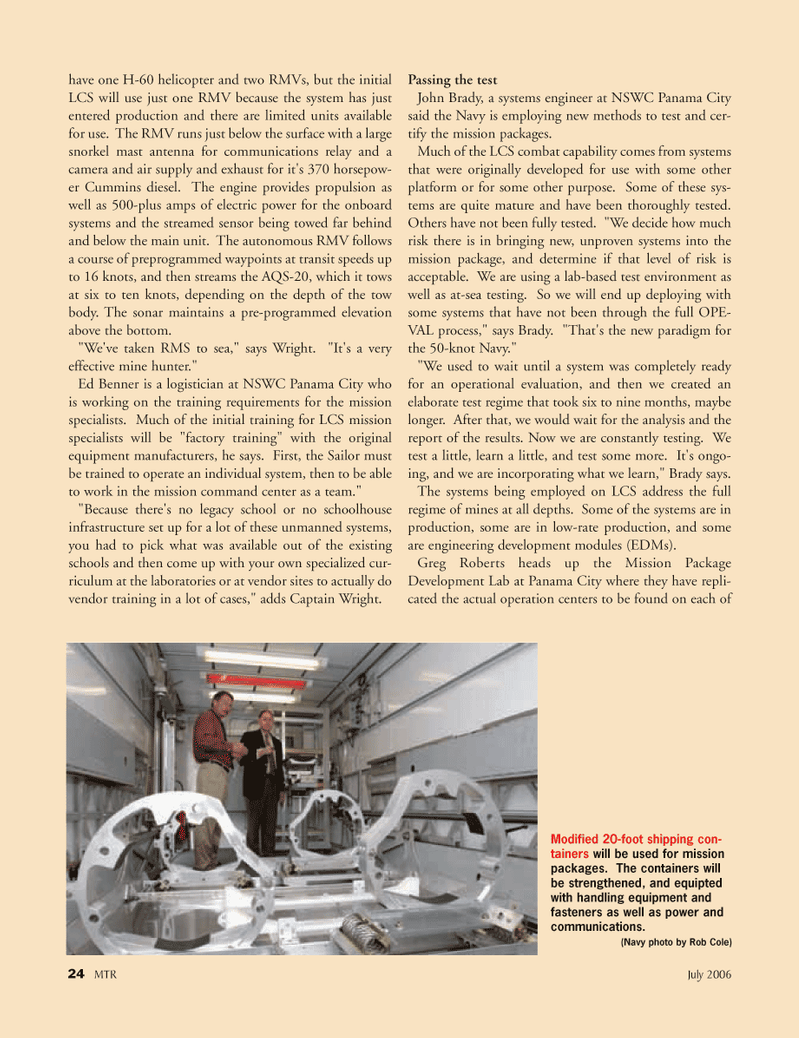
Page 24: of Marine Technology Magazine (July 2006)
Underwater Defense: Port & Harbor Security
Read this page in Pdf, Flash or Html5 edition of July 2006 Marine Technology Magazine
24 MTR July 2006 have one H-60 helicopter and two RMVs, but the initial
LCS will use just one RMV because the system has just entered production and there are limited units available for use. The RMV runs just below the surface with a large snorkel mast antenna for communications relay and a camera and air supply and exhaust for it's 370 horsepow- er Cummins diesel. The engine provides propulsion as well as 500-plus amps of electric power for the onboard systems and the streamed sensor being towed far behind and below the main unit. The autonomous RMV follows a course of preprogrammed waypoints at transit speeds up to 16 knots, and then streams the AQS-20, which it tows at six to ten knots, depending on the depth of the tow body. The sonar maintains a pre-programmed elevation above the bottom. "We've taken RMS to sea," says Wright. "It's a very effective mine hunter."
Ed Benner is a logistician at NSWC Panama City who is working on the training requirements for the mission specialists. Much of the initial training for LCS mission specialists will be "factory training" with the original equipment manufacturers, he says. First, the Sailor must be trained to operate an individual system, then to be able to work in the mission command center as a team." "Because there's no legacy school or no schoolhouse infrastructure set up for a lot of these unmanned systems, you had to pick what was available out of the existing schools and then come up with your own specialized cur- riculum at the laboratories or at vendor sites to actually do vendor training in a lot of cases," adds Captain Wright.
Passing the test
John Brady, a systems engineer at NSWC Panama City said the Navy is employing new methods to test and cer- tify the mission packages.
Much of the LCS combat capability comes from systems that were originally developed for use with some other platform or for some other purpose. Some of these sys- tems are quite mature and have been thoroughly tested.
Others have not been fully tested. "We decide how much risk there is in bringing new, unproven systems into the mission package, and determine if that level of risk is acceptable. We are using a lab-based test environment as well as at-sea testing. So we will end up deploying with some systems that have not been through the full OPE-
VAL process," says Brady. "That's the new paradigm for the 50-knot Navy." "We used to wait until a system was completely ready for an operational evaluation, and then we created an elaborate test regime that took six to nine months, maybe longer. After that, we would wait for the analysis and the report of the results. Now we are constantly testing. We test a little, learn a little, and test some more. It's ongo- ing, and we are incorporating what we learn," Brady says.
The systems being employed on LCS address the full regime of mines at all depths. Some of the systems are in production, some are in low-rate production, and some are engineering development modules (EDMs).
Greg Roberts heads up the Mission Package
Development Lab at Panama City where they have repli- cated the actual operation centers to be found on each of
Modified 20-foot shipping con- tainers will be used for mission packages. The containers will be strengthened, and equipted with handling equipment and fasteners as well as power and communications. (Navy photo by Rob Cole)
MTR#6 (17-32).qxd 7/11/2006 8:48 AM Page 24

 23
23

 25
25
